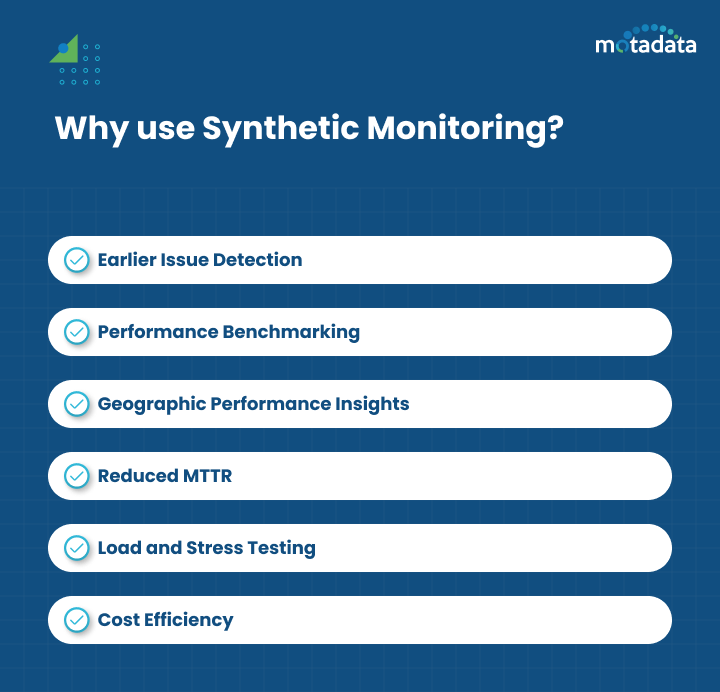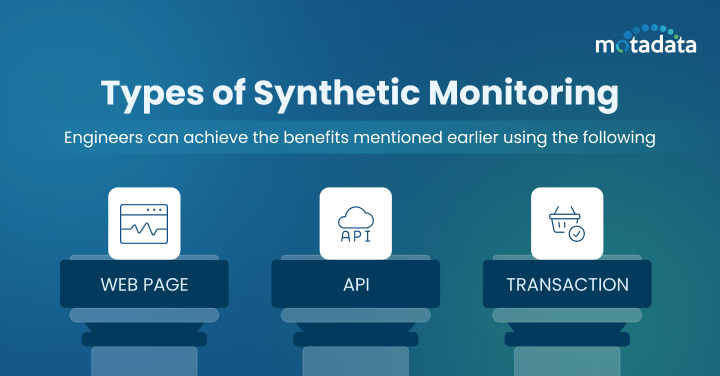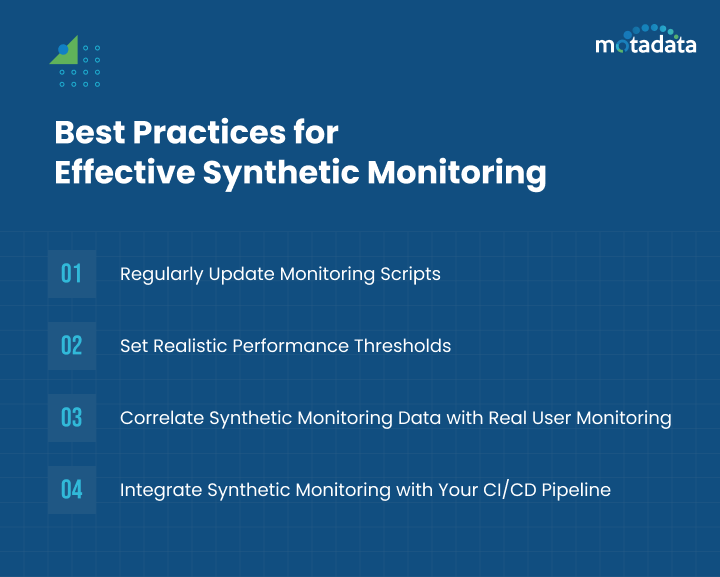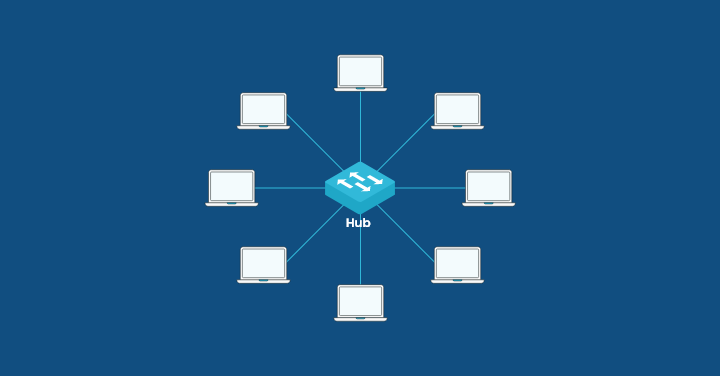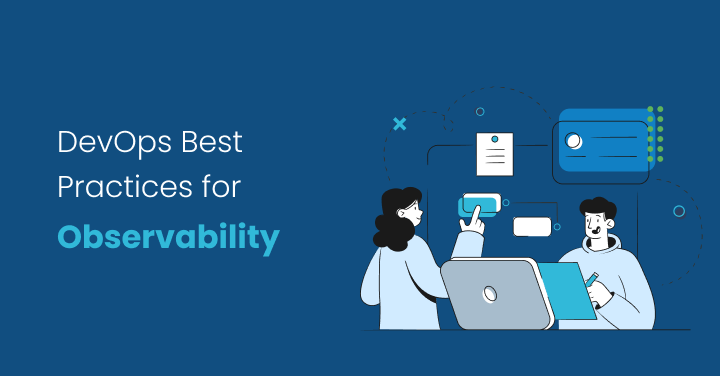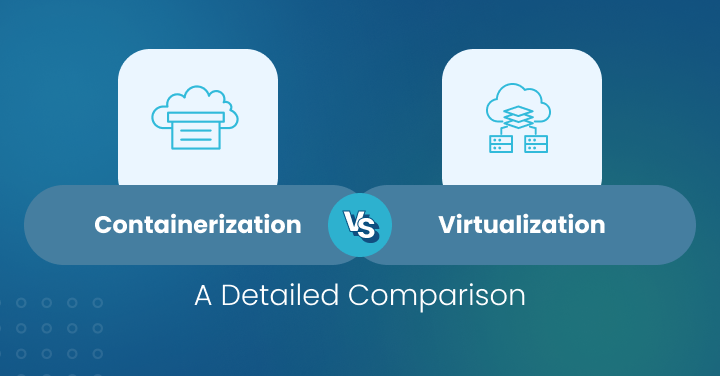Making your brand stand out in digital business is more challenging than it sounds.
More than 2.87 million apps are available on Play store and other platforms. In fact, as per reports, almost 252,000 new websites are created and launched daily.
Competing in this large market without proper monitoring and strategy is a complete waste of time.
One needs to keep various aspects in mind, including top-quality application management, faster software delivery, smooth user experience, etc., to stay ahead of competitors.
Synthetic monitoring is a modern practice that can help businesses assess application performance and functionality.
It is a proactive monitoring technique that uses scripts to analyze a user’s experience when using your app or website.
Instead of collecting data from actual user activities, it generates artificial traffic and executes predefined scenarios to predict problems and identify performance bottlenecks earlier.
Let’s learn how Synthetic Monitoring works, its importance, types, challenges, and best practices. Then, we will explain how synthetic monitoring differs from accurate user monitoring.
What is Synthetic Monitoring?
Synthetic monitoring is a popular technique used by professionals to get a quick overview of their application functionalities and performance.
Also referred to as active monitoring practice, it simulates user interactions across different browsers, device types, and scenarios via scripts.
These automated scripts collect data and provide insights into performance issues and overall system health.
How Does Synthetic Monitoring Work?
Synthetic Monitoring processes run synthetic transactions or automated scripts through the applications and websites to check response time, load time, and performance across different browsers, devices, and locations.
Simulated traffic is sent to these applications via browser or device to assess new features before turning them live.
Business professionals and engineers can install these robot client applications manually or use a synthetic monitoring tool to run automated tests and analyze overall system performance.
You can run them continuously at predefined intervals without stressing over incoming traffic and load, as they need more resources.
Each time an engineer runs these scripts, a response is submitted to the synthetic monitoring system. If the engineer finds an issue or error, it re-runs the test to confirm and troubleshoot the issue before it escalates.
Why use Synthetic Monitoring?
Organizations exercise synthetic monitoring practices for several reasons, such as:
- Earlier Issue Detection: Users can identify short-term errors or problems in your application before they affect real users. Thus saving your brand reputation and guaranteeing customer satisfaction.
- Performance Benchmarking: Synthetic monitoring enables teams to measure performance against predefined benchmarks or competitor applications. They help identify deviations by comparing collected insights with historical data and fixing issues.
- Geographic Performance Insights: By testing from multiple global locations, synthetic monitoring reveals regional performance discrepancies. The insights collected might need to be more accurate, but it helps identify page load speed issues, network latency, etc.
- Reduced MTTR: Early detection of issues enables teams to resolve issues faster and minimize downtime.
- Load and Stress Testing: Synthetic testing enables organizations to conduct thorough app testing by assessing how applications perform under heavy traffic loads through simulating thousands of concurrent users. This helps identify bottlenecks and ensures scalability.
- Cost Efficiency: Downtime and poor performance can result in financial losses, especially for businesses relying on digital services. Synthetic monitoring minimizes these risks by proactively identifying issues, thereby saving revenue.
How to Analyze Synthetic User Monitoring Data?
To analyze synthetic monitoring data, it is vital to interpret all the information collected from the synthetic monitoring tool by simulating user interaction.
First, understand how long your application or website takes to respond to user requests, check availability and error rates, measure loading time, and other key metrics.
Compare the received information with baseline metrics to understand deviations and take proper actions.
Also, it is essential to evaluate application performance across multiple locations and regions to ensure network latency.
Track any failed transactions, timeouts, or recurring patterns that can cause performance issues in the future. You can even rely on visualization tools to track potential problem areas.
Synthetic Monitoring vs RUM: How Do They Differ?
Synthetic Monitoring techniques and accurate user monitoring (RUM) methods differ.
In real user monitoring, engineers track user actions and behavior to identify long-term performance trends and problems and resolve them.
However, the synthetic monitoring technique simulates artificial traffic to short-term issues and potential performance problems before they escalate and impact end-user experience.
Further, JavaScript code is injected into webpages using the RUM technique to collect and analyze data. On the other hand, synthetic monitoring uses automated scripts to simulate transactions.
What is the significance of Synthetic Monitoring Tools?
Synthetic monitoring comes with various benefits that can significantly improve your digital experience.
From early detection of issues to application feature availability checks, this technique helps overcome real-time performance challenges and secures your brand’s reputation.
Here are a few benefits that a business can encounter with synthetic monitoring tools:
Proactive issue detection
The tool allows engineers to detect issues in the application performance and feature functionalities early.
Stimulating user interaction prevents real users from facing irregularities and outages in the application, thus guaranteeing a better user experience on launch.
Improved user experience
With regular monitoring of user actions and paths, businesses guarantee a seamless user experience and quality performance.
Faster incident resolution
This technique monitors performance over different browsers and multiple locations. It immediately alerts the client upon detecting any error or fault, resulting in quick response and troubleshooting.
Thus, it helps reduce the mean time to resolution (MTTR).
Enhanced application performance
Various factors, such as server delays and slow loading time, can affect your application performance. However, this monitoring technique allows DevOps teams to identify bottlenecks early and optimize performance.
Validation of SLAs
Organizations can validate SLA compliance by measuring uptime, response times, and availability against predefined thresholds.
Capacity planning
Businesses can evaluate their infrastructure capacity and scalability for future needs and expansion by simulating user activities and gaining early insights into traffic load.
Analysis of Competitor Performance
Synthetic monitoring tools provide detailed insights into your application performance. You can use this data to compare with your competitor applications and pinpoint areas for improvement.
Thus enabling teams to stay ahead and increase revenue.
Types of Synthetic Monitoring
Engineers can achieve the benefits mentioned earlier using the following synthetic monitoring types:
- Web Page Monitoring: This type of monitoring allows organizations to track their web page content and different elements, loading speed, response time, and potential errors that can hamper user experience. It monitors different website metrics for better experience across browsers and devices.
- API Monitoring: Organizations use internal and external APIs to ensure smooth website or application performance. With this synthetic monitoring type, organizations can monitor underperforming APIs and bottlenecks beforehand.
- Transaction Monitoring: In e-commerce websites and applications, users often perform a regular set of actions to complete a transaction, such as logging in, adding to a cart, form completion, checkout, etc. Transaction monitoring practice is performed to ensure no delays or errors in these paths. Moreover, Generative AI in eCommerce enhances transaction monitoring by simulating user flows to detect potential issues before they impact real transactions.
Implementing Synthetic Monitoring
Synthetic Monitoring Tool Implementation is a simple process that doesn’t require technical skills and expertise.
Follow these simple steps to enjoy the benefits of synthetic monitoring:
Choosing the Right Tools
Choosing the right tool to measure your performance, run API tests, track transactions, and perform other tasks in application monitoring is vital.
So, set your goals and check your needs and budget before finalizing a monitoring tool for your application.
Look for a monitoring solution that is easy to set up and manage. A user-friendly design with a robust reporting system that pinpoints issues and spots trends in real-time.
Setting Up Monitoring Scenarios
Once you have the tool in hand, determine the situations you want to monitor in your application to deliver a smooth user experience.
Keep the typical user behavior patterns in mind when making your decision. You can set monitors for different scenarios, browsers, click paths, broken links, HTTP requests, etc.
Analyzing Monitoring Data
Data collection is essential, but data interpretation and analysis matter most.
Ensure your selected tool generates insightful reports that help visualize your performance metrics, spot trends, and identify real-time bottlenecks.
It properly details your response time, resource usage, error rates, etc.
What are the Major Challenges of Synthetic Monitoring?
Modern applications are more complex as they have various features, contexts, and settings. Monitoring these complex modern applications using traditional monitoring tools is not possible.
Hence, most businesses are relying on synthetic monitoring tools, but here is the catch: Synthetic monitoring tools have various key benefits, but it is also challenging in some cases –
1. Script Maintenance
The predefined scripts play an essential role in simulating user actions. But do you know how challenging it is to maintain these scripts as updates are constantly run over systems and feature modifications are done? Frequent updates require ongoing manual intervention, increasing operational overhead.
2. Coverage and Scalability
While synthetic monitoring can cover critical user flows, its ability to scale across many use cases is often limited.
Providing thorough test coverage for all application functionalities becomes resource-intensive, particularly for complex and large-scale systems.
3. Geographic Accuracy
Synthetic monitoring simulates user interactions using specified testing nodes, which may not always accurately reflect the real-world experience of users from various geographic regions.
Differences in network circumstances, latency, or content delivery may need to be addressed, resulting in incorrect performance data.
4. Dynamic Content
Modern applications contain dynamic or regularly changing data, which might be challenging to monitor using synthetic techniques efficiently.
Live data and A/B testing are all examples of elements that might cause scripted interactions to fail or miss crucial performance metrics.
5. Limited Real-World Insight
Since the tool doesn’t collect user actions, it needs more insights into how real users experience the application under varying devices. This gap may leave critical performance issues undetected.
Best Practices for Effective Synthetic Monitoring
To stay ahead of your competitors, it is crucial to implement a robust synthetic monitoring strategy that helps in APIs, business transactions, and web performance monitoring and management.
Here are a few best practices that can help businesses achieve their desired results and long-term success:
1. Regularly Update Monitoring Scripts
Most systems and applications frequently update for security reasons. Apart from this, adding new features and design modifications are common.
In such a case, script maintenance can be challenging, but constantly updating your monitoring scripts can help maintain accuracy.
Ease the overall task by adding script updates to your continuous integration and continuous delivery (CI/CD) pipeline.
As a result, it will automatically update your monitoring system when code changes happen—further reducing false alerts and guaranteeing smooth workflow.
2. Set Realistic Performance Thresholds
Establish performance baselines and thresholds based on your previous data and identify deviations, as these act as alarms.
Unrealistic or overly strict thresholds can generate false alarms that can lead to leaving real problems unnoticed. Hence, keep actual users in mind when you set these thresholds.
3. Correlate Synthetic Monitoring Data with Real User Monitoring (RUM)
Connect synthetic monitoring with Real User Monitoring (RUM) to comprehensively view your application performance and decision-making.
Synthetic tests will help highlight short-term app problems beforehand, whereas RUM provides insights after observing what real users do.
Mix both methods to identify issues faster. Using these insights, IT teams can pinpoint performance gaps quickly and prioritize fixes.
4. Integrate Synthetic Monitoring with Your CI/CD Pipeline
Integrate synthetic monitoring into your CI/CD pipeline to detect performance concerns early in the development cycle.
By automating performance checks during code deployments, you may detect regressions and improve application reliability before they reach production.
This integration speeds up issue response and improves the overall experience for customers.
Conclusion
Modern applications upgrade various features, layouts, contexts, and settings to fulfill users’ demands and stand out.
Complex applications also imply they will have multiple challenges and errors that can be hard to identify using traditional monitoring practices.
Hence, it is best to invest in synthetic monitoring tools to gain more clarity into how your applications are running and performing.
Synthetic monitoring is a passive monitoring technique simulating user actions using automated scripts across web and mobile channels to pinpoint faults and issues.
This technique has gained much attention over the years because it helps identify short-term problems before they impact user experience.
It provides insights into application availability, error rates, response time, the root cause of a web application issue, etc., which helps gain a quick overview of your entire app or web performance. With multiple benefits, the practice also comes with various challenges.
Motadata Synthetic Monitoring is one of the trusted platforms that can assist you in overcoming these challenges and identifying application faults in real-time.
The tool simulates user activity across browsers, web, mobile, and transactions for smooth customer performance.
It comes with advanced monitoring capabilities that help track potential bottlenecks and issues worldwide.
You can also avail of a free trial for Motadata Synthetic Monitoring with a visit.
Invest in the right synthetic monitoring solution to deliver a better customer experience.
FAQs:
Synthetic monitoring uses scripts to simulate artificial traffic and spot errors in the application, whereas RUM monitors actual user activities and behavior to identify potential performance problems.
Synthetic monitoring involves script creation and execution across multiple locations, devices, browsers, and testing nodes. It constantly tracks key performance metrics and generates alerts to identify performance errors or deviations. The process further involves generating visual reports highlighting patterns, issues, and trends.
With the help of a synthetic monitoring solution, the DevOps team and engineers can track the following performance metrics, including:
- Uptime/Downtime: Helps track application availability.
- Response Time: How much it is taking for the application to respond to a client request
- Transaction Time: Time taken to perform transaction tasks, such as checkout, add to cart, login, etc.
- Latency: Network delays impacting performance
- Error Rate: How frequently are user transactions failing or HTTP errors?
To ensure accuracy, manage the significant challenges of synthetic monitoring techniques, i.e., script maintenance, dynamic content handling, tests from geographically distributed nodes, etc.
Yes, synthetic monitoring can assist in identifying potential security vulnerabilities. It can simulate specific test scenarios, such as checking for unauthorized access points, identifying performance changes due to security threats, or detecting unusual network behavior that may indicate a threat or risk.
Reduced downtime, cost-saving evaluation, and assessing customer satisfaction are a few areas that can help measure the ROI of synthetic monitoring.


